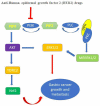Roles of Nrf2 in Gastric Cancer: Targeting for Therapeutic Strategies
- PMID: 34070502
- PMCID: PMC8198360
- DOI: 10.3390/molecules26113157
Roles of Nrf2 in Gastric Cancer: Targeting for Therapeutic Strategies
Abstract
Nuclear Factor Erythroid 2-Related Factor 2 (Nrf2) is a specific transcription factor with potent effects on the regulation of antioxidant gene expression that modulates cell hemostasis under various conditions in tissues. However, the effects of Nrf2 on gastric cancer (GC) are not fully elucidated and understood. Evidence suggests that uncontrolled Nrf2 expression and activation has been observed more frequently in malignant tumors, including GC cells, which is then associated with increased antioxidant capacity, chemoresistance, and poor clinical prognosis. Moreover, Nrf2 inhibitors and the associated modulation of tumor cell redox balance have shown that Nrf2 also has beneficial effects on the therapy of various cancers, including GC. Based on previous findings on the important role of Nrf2 in GC therapy, it is of great interest to scientists in basic and clinical tumor research that Nrf2 can be active as both an oncogene and a tumor suppressor depending on different background situations.
Keywords: Nrf2 inhibitor; Nrf2 pathway; antioxidants; gastric cancer.
Conflict of interest statement
The authors declare no conflict of interest.
Figures
Similar articles
-
Nrf2 overexpression predicts prognosis and 5-FU resistance in gastric cancer.Asian Pac J Cancer Prev. 2013;14(9):5231-5. doi: 10.7314/apjcp.2013.14.9.5231. Asian Pac J Cancer Prev. 2013. PMID: 24175806
-
BDH2 triggers ROS-induced cell death and autophagy by promoting Nrf2 ubiquitination in gastric cancer.J Exp Clin Cancer Res. 2020 Jun 30;39(1):123. doi: 10.1186/s13046-020-01620-z. J Exp Clin Cancer Res. 2020. PMID: 32605589 Free PMC article.
-
Emerging role of NRF2 in ROS-mediated tumor chemoresistance.Biomed Pharmacother. 2020 Nov;131:110676. doi: 10.1016/j.biopha.2020.110676. Epub 2020 Aug 25. Biomed Pharmacother. 2020. PMID: 32858502 Review.
-
Clinicopathological significance of nuclear factor (erythroid-2)-related factor 2 (Nrf2) expression in gastric cancer.BMC Cancer. 2015 Jan 15;15:5. doi: 10.1186/s12885-015-1008-4. BMC Cancer. 2015. PMID: 25588809 Free PMC article.
-
"NRF2 addiction" in lung cancer cells and its impact on cancer therapy.Cancer Lett. 2019 Dec 28;467:40-49. doi: 10.1016/j.canlet.2019.09.016. Epub 2019 Sep 28. Cancer Lett. 2019. PMID: 31574294 Review.
Cited by
-
3,4‑Dihydroxyacetophenone attenuates oxidative stress‑induced damage to HUVECs via regulation of the Nrf2/HO‑1 pathway.Mol Med Rep. 2022 Jun;25(6):199. doi: 10.3892/mmr.2022.12715. Epub 2022 Apr 27. Mol Med Rep. 2022. PMID: 35475506 Free PMC article.
-
Resveratrol as an Adjunctive Therapy for Excessive Oxidative Stress in Aging COVID-19 Patients.Antioxidants (Basel). 2021 Sep 9;10(9):1440. doi: 10.3390/antiox10091440. Antioxidants (Basel). 2021. PMID: 34573071 Free PMC article. Review.
-
Mitigation of Cardiovascular Disease and Toxicity through NRF2 Signalling.Int J Mol Sci. 2023 Apr 4;24(7):6723. doi: 10.3390/ijms24076723. Int J Mol Sci. 2023. PMID: 37047696 Free PMC article. Review.
-
Hawk Tea Flavonoids as Natural Hepatoprotective Agents Alleviate Acute Liver Damage by Reshaping the Intestinal Microbiota and Modulating the Nrf2 and NF-κB Signaling Pathways.Nutrients. 2022 Sep 5;14(17):3662. doi: 10.3390/nu14173662. Nutrients. 2022. PMID: 36079919 Free PMC article.
-
Nrf2-mediated ferroptosis inhibition: a novel approach for managing inflammatory diseases.Inflammopharmacology. 2024 Oct;32(5):2961-2986. doi: 10.1007/s10787-024-01519-7. Epub 2024 Aug 10. Inflammopharmacology. 2024. PMID: 39126567 Review.
References
-
- Wright N.A., Poulsom R., Stamp G., van Noorden S., Sarraf C., Elia G., Ahnen D., Jeffery R., Longcroft J., Pike C., et al. Trefoil peptide gene expression in gastrointestinal epithelial cells in inflammatory bowel disease. Gastroenterology. 1993;104:12–20. doi: 10.1016/0016-5085(93)90830-6. - DOI - PubMed
-
- Ashrafizadeh M., Zarrabi A., Hashemipour M., Vosough M., Najafi M., Shahinozzaman M., Hushmandi K., Khan H., Mirzaei H. Sensing the scent of death: Modulation of microRNAs by Curcumin in gastrointestinal cancers. Pharmacol. Res. 2020;160:105199. - PubMed
Publication types
MeSH terms
Substances
LinkOut - more resources
Full Text Sources
Medical
Miscellaneous



